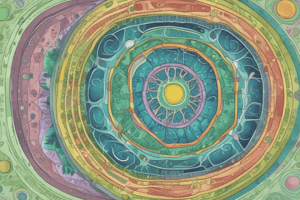Podcast
Questions and Answers
What is the main function of the cell wall in a plant cell?
What is the main function of the cell wall in a plant cell?
To provide support and protection
What is the selective permeability of the cell membrane necessary for?
What is the selective permeability of the cell membrane necessary for?
To allow nutrient uptake and waste removal
What is the site of metabolic reactions and protein synthesis in a plant cell?
What is the site of metabolic reactions and protein synthesis in a plant cell?
The cytoplasm
Which organelle is responsible for cellular respiration?
Which organelle is responsible for cellular respiration?
What is the function of chloroplasts in a plant cell?
What is the function of chloroplasts in a plant cell?
What is the purpose of lysosomes in a plant cell?
What is the purpose of lysosomes in a plant cell?
What is the role of vacuoles in a plant cell?
What is the role of vacuoles in a plant cell?
What is the function of the Golgi apparatus in a plant cell?
What is the function of the Golgi apparatus in a plant cell?
What is the purpose of the cytoskeleton in a plant cell?
What is the purpose of the cytoskeleton in a plant cell?
What is the site of protein synthesis in a plant cell?
What is the site of protein synthesis in a plant cell?
Flashcards are hidden until you start studying
Study Notes
Plant Cell Structure
Cell Wall
- Rigid outer layer providing support and protection
- Composed of cellulose, hemicellulose, and pectin
- Cellulose microfibrils provide strength and direction
Cell Membrane
- Semi-permeable membrane regulating movement of substances
- Phospholipid bilayer with embedded proteins
- Selectively permeable to allow nutrient uptake and waste removal
Cytoplasm
- Jelly-like substance inside cell membrane
- Site of metabolic reactions and protein synthesis
- Contains various organelles and inclusions
Organelles
- Nucleus: contains genetic material (DNA)
- Mitochondria: site of cellular respiration (energy production)
- Chloroplasts: site of photosynthesis (light-dependent reactions)
- Endoplasmic Reticulum (ER): involved in protein synthesis and transport
- Golgi Apparatus: involved in protein modification and packaging
- Lysosomes: contain digestive enzymes for cellular recycling
- Plastids: various types, including chloroplasts, chromoplasts, and amyloplasts
Vacuoles
- Membrane-bound organelles storing water, salts, and nutrients
- Help maintain cell turgor pressure
- Can also store waste products and recycle cellular materials
Plastids
- Chloroplasts: contain pigments (chlorophyll) for photosynthesis
- Chromoplasts: contain pigments for flower and fruit coloration
- Amyloplasts: store starch for energy storage
Other Components
- Cytoskeleton: provides structural support and shape
- Ribosomes: site of protein synthesis
- Peroxisomes: involved in breakdown of fatty acids and amino acids
Plant Cell Structure
Cell Wall
- Rigid outer layer providing support and protection to the cell
- Composed of cellulose, hemicellulose, and pectin
- Cellulose microfibrils provide strength and direction to the cell wall
Cell Membrane
- Semi-permeable membrane regulating movement of substances in and out of the cell
- Phospholipid bilayer with embedded proteins that facilitate transport
- Selectively permeable to allow nutrient uptake and waste removal
Cytoplasm
- Jelly-like substance inside the cell membrane where metabolic reactions and protein synthesis occur
- Contains various organelles and inclusions that perform specific functions
Organelles
- Nucleus: contains genetic material (DNA) and controls cell growth and reproduction
- Mitochondria: site of cellular respiration where energy is produced for the cell
- Chloroplasts: site of photosynthesis where light energy is converted to chemical energy
- Endoplasmic Reticulum (ER): involved in protein synthesis, transport, and storage
- Golgi Apparatus: involved in protein modification, packaging, and secretion
- Lysosomes: contain digestive enzymes for cellular recycling and waste removal
- Plastids: various types, including chloroplasts, chromoplasts, and amyloplasts, involved in photosynthesis and pigment synthesis
Vacuoles
- Membrane-bound organelles storing water, salts, and nutrients for cellular functions
- Help maintain cell turgor pressure and structural integrity
- Can also store waste products and recycle cellular materials
Plastids
- Chloroplasts: contain pigments (chlorophyll) for photosynthesis and light-dependent reactions
- Chromoplasts: contain pigments responsible for flower and fruit coloration
- Amyloplasts: store starch for energy storage and plant growth
Other Components
- Cytoskeleton: provides structural support, shape, and mechanical strength to the cell
- Ribosomes: site of protein synthesis where mRNA is translated into amino acid sequences
- Peroxisomes: involved in breakdown of fatty acids and amino acids for energy production
Studying That Suits You
Use AI to generate personalized quizzes and flashcards to suit your learning preferences.




